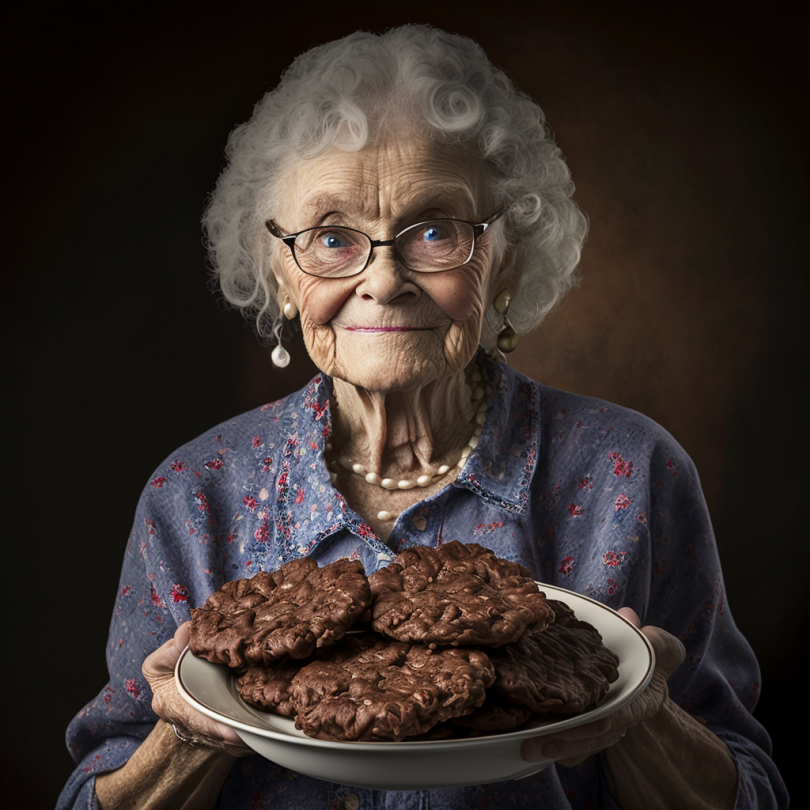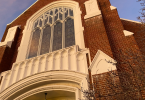Sister Gilchrist, a spinster we occasionally ferried to church, was my fifth grade Sunday School teacher. I remember her as bright-eyed, quick-witted, and funny.
She brought creativity to her classroom in our fundamentalist church: cloth figures that acted out plays, paper bag puppets that embodied prophets, shoe box manger scenes. I distinctly remember sitting in a chair atop a table while other children paraded around me, celebrating my coronation as King Josiah.
In a place where even the adult Bible classes offered little more than fill-in-the-blank study guides, Sister Gilchrist’s class was a marvel.
Every Sunday, she would also bring us a special gift: chocolate oatmeal no-bake cookies, carefully wrapped in foil. To this day, I call these “Sister Gilchrist cookies,” and seeing them in the case at Sugaree’s Bakery here in New Albany evokes her gentle, artistic spirit in my heart again and again.
I loved those cookies, and I loved Sister Gilchrist. That elderly spinster from a small town in Alabama left us a rich legacy: the idea that Bible classes can be engaging, that the arts can bring us closer to Spirit, and that a little touch of sweetness can inspire memories that last a lifetime.
When I think of Sister Gilchrist, my heart warms … but it also breaks, and not just because she’s long gone.
I was baptized far too early, at the tender age of nine years old. We would never allow children to sign mortgages or contracts, but in fundamentalist churches everywhere, young children are encouraged to accept Jesus Christ as their personal Savior — a lifetime contract — long before they have any grasp of what that obligation implies.
I can also attest that, when I agreed to be dunked under the faintly algae-tinted waters of our baptistry, I had no idea of one terrible consequence I would face: the men of the church would ask Sister Gilchrist to step down as my Sunday School teacher.
According to the church of my childhood, the nine year-old kid who woke up a boy at six o’clock on Sunday became a man when he was baptized on Sunday at noon. And because our church advocated a literal, orthodox reading of Scripture, Sister Gilchrist’s presence in the classroom violated 1 Timothy 2:12: “But I suffer not a woman to teach, nor to usurp authority over the man, but to be in silence.”
And so: because I’d been baptized … Sister Gilchrist, rather than be allowed to teach “a man,” was silenced.
The next Sunday, in her place, we faced a dull lump of a fellow with no imagination. He made us read aloud from dumbed-down texts, asked us no questions, and gave us sheets of fill-in-the-blank Scriptures to complete.
To this day, I remember our despair — and the pain this decision caused Sister Gilchrist. In the wake of this choice, the men of our church created a legacy of their own: one of ignorance, of insensitivity, of ingratitude, of insanity.
Almost half a century later, as the storm of disaffiliation rages within the United Methodist Church, I wonder about the legacy being forged. More to the point, I wonder what the children will remember.
What impression do we make when long time friends become enemies? How does the bitter rhetoric sound in tiny ears? How will children feel when some of their classmates are gone? And how will an entire generation — already the least likely of any American generation to remain in church — judge us when they learn we split the church over the mere possibility that, someday, at some time, we might be asked to recognize that people Not Like Us are also Children of God?
When the crisis came, we didn’t pull together. We fell apart.
Long after you and I are gone, the children will remember this legacy.







